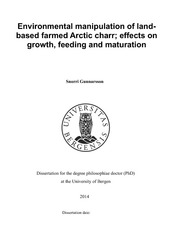| dc.contributor.author | Gunnarsson, Snorri | eng |
| dc.date.accessioned | 2014-05-26T09:46:01Z | |
| dc.date.available | 2014-05-26T09:46:01Z | |
| dc.date.issued | 2014-05-08 | eng |
| dc.identifier.isbn | 978-82-308-2914-1 | en_US |
| dc.identifier.uri | http://hdl.handle.net/1956/7936 | |
| dc.description.abstract | Farming of Arctic charr takes mainly place in land-based farms applying intensive rearing methods with relatively high production costs. Depending on local conditions at each site, it is possible to regulate important environmental factors to improve productivity and well-being of the fish. Knowledge about how these different environmental factors affect various farming traits are therefore important to reduce production costs. The aim to this thesis was to investigate how rearing temperature, photoperiod, salinity and feeding rations can be used to enhance the production of land-based Arctic charr. Rearing temperature is a highly effective tool to improve growth rate of Arctic charr. (Paper I). Juvenile Arctic charr reared at a constant temperature of 15 °C had mean weights that were 44 % and 78 % higher than fish reared at constant temperatures of 12 and 9 C, respectively. Attempts to transfer the Arctic charr down in rearing temperature as an effort to follow the drop in temperature optima for growth resulted in a consistently negative effects on the growth rate. High growth rates as observed at the higher temperature groups (Paper I) with subsequent high condition factor lead to higher incidence of maturation. Rearing of Arctic charr at periodic restricted feed rations (50 %) in Paper II led to full growth compensation (CG) of the farmed Arctic charr. Restricted feed groups had both higher feed intake and feed conversion efficiency during the re-feeding periods compared to the full ration group. Periodical feed restriction regimes had lower maturation level compared to full ration groups. The application of a six week short photoperiod within other ways continuous photoperiod improved long term growth rate of Arctic charr reared in freshwater (Paper III). Short day groups weighed 10.7–13.9 % more than the group reared on continuous light. Feed intake and feeding conversion efficiency increased following transfer to continuous light after a period of short day (Paper III) explaining the growth enhancement effect. Rearing salinity affected growth rate of Arctic charr and was higher for the lower salinity groups and maturation was lower and delayed (Paper IV) in these same groups. Final weights of female Arctic charr reared at 17 ‰ were 19 % and 27 % higher than for the females in the 17-27 ‰ and 27 ‰ groups, respectively. Effort to induce the smoltification by application of a six week short day signal during early winter followed by transfer to continuous light (Paper IV) failed as no differences in neither gill NKA nor plasma Na+ levels were detected compared with a control group kept at continuous light. Higher long term growth in the group receiving short day treatment in early winter is therefore likely linked to higher feed intake and or improved feeding efficiency following return to continuous light like demonstrated in Paper III rather than improved seawater tolerance for that group. Overall there appear to be an interactive effect on maturation from applying short-day photoperiod and subsequent rearing at higher salinity as GSI was higher in the short day groups reared at higher salinities. In the thesis it has been demonstrated how rearing temperature, photoperiod, salinity and feeding ratio can affect farming traits like growth rate, maturation and feed conversion efficiency. High growth rate during juvenile phase as observed in the higher temperature groups (Paper I) can result in higher incidence of maturation during on growing period. Photoperiod manipulation and feed ration can be used as tools to improve growth and reduce maturation. Salinity has negative effect on growth rate but farmers with rich access to brackish water may get acceptable growth rates during on growing period. Future studies should focus on better preserving the potential high growth rate of Arctic charr during juvenile phase into the on growing period and establish protocols to improve the seawater tolerance of Arctic charr. | en_US |
| dc.language.iso | eng | eng |
| dc.publisher | The University of Bergen | en_US |
| dc.relation.haspart | Paper I: Gunnarsson, S., Imsland, A.K., Árnason, J., Gústavsson, A., Arnason, I., Jónsson, J.K., Foss, A., Stefansson, S. and Thorarensen, H. (2011). Effect of rearing temperatures on the growth and maturation of Arctic charr (Salvelinus alpinus) during juvenile and on-growing periods. Aquaculture Research, 42: 211-229. The article is not available in BORA due to publisher restrictions. The published version is available at: <a href="http://dx.doi.org/10.1111/j.1365-2109.2010.02615.x" target="blank"> http://dx.doi.org/10.1111/j.1365-2109.2010.02615.x </a> | en_US |
| dc.relation.haspart | Paper II: Imsland, A.K. and Gunnarsson, S. (2011). Growth and maturation in Arctic charr (Salvelinus alpinus) in response to different feed rations. Aquaculture. 318 (3-4): 407-411. The article is not available in BORA due to publisher restrictions. The published version is available at: <a href="http://dx.doi.org/10.1016/j.aquaculture.2011.05.049" target="blank">http://dx.doi.org/10.1016/j.aquaculture.2011.05.049</a> | en_US |
| dc.relation.haspart | Paper III: Gunnarsson, S., Imsland, A.K., Siikavuopio, S.I., Árnason, J., Gústavsson, A. and Thorarensen, H. (2012). Enhanced growth of farmed Arctic charr (Salvelinus alpinus) following a short-day photoperiod. Aquaculture. 350-353: 75-81. The article is not available in BORA due to publisher restrictions. The published version is available at: <a href="http://dx.doi.org/10.1016/j.aquaculture.2012.04.014" target="blank">http://dx.doi.org/10.1016/j.aquaculture.2012.04.014</a> | en_US |
| dc.relation.haspart | Paper IV: Gunnarsson, S., Johansson, M., Gústavsson, A., Árnason, T., Árnason, J., Smáradóttir, H., Björnsson, B.Th., Thorarensen, H. and Imsland, A.K. (2013). Effects of short-day treatment on long term growth performance and maturation of farmed Arctic charr Salvelinus alpinus reared in brackish water. The article is not available in BORA. | en_US |
| dc.title | Environmental manipulation of land-based farmed Arctic charr; effects on growth, feeding and maturation | en_US |
| dc.type | Doctoral thesis | |
| dc.rights.holder | Copyright the author. All rights reserved | en_US |
